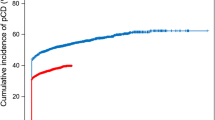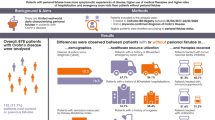Abstract
Purpose
Perianal Crohn’s disease (CD) encompasses a variety of lesion similar to luminal disease, which are usually not distinctly assessed. Links between luminal and perianal CD phenotype remains therefore underreported, and we aimed to describe both luminal and perianal phenotype and their relationships.
Methods
From January 2007, clinical data of all consecutive patients with CD seen in a referral center were prospectively recorded. Data recorded until October 2011 were extracted and reviewed for study proposal.
Results
A total of 282 patients (M/F, 108/174; aged 37.8 ± 16.2 years) were assessed that included 154 cases (54.6 %) with anal ulceration, 118 cases (41.8 %) with fistula, 49 cases (17.4 %) with stricture, and 94 cases without anal lesion (33.3 %). Anal ulcerations were associated with fistulas (N = 87/154) in more than half of patients (56.5 %) and were isolated in 55 patients (35.7 %). Most of strictures (94 %) were associated with other lesions (N = 46/49). Harvey-Bradshaw score was significantly higher in patients with ulcerations (p < 0.001) as compared to those with perianal fistulas (p = 0.15) or with anal strictures (p = 0.16). Proportions of complicated behavior (fistulizing or stricturing) of luminal CD were similar according to anal lesions: anal fistulas were not significantly associated to penetrating Montreal phenotype (N = 4/31 p = 0.13) as well as anal stricture and stricturing Montreal phenotype (N = 3/49, p = 0.53).
Conclusions
The phenotype of luminal disease does not link with the occurrence and the phenotype of perianal Crohn’s disease. Anal ulcerations denote a more severe disease on both luminal and perianal locations and should consequently be taking into account in physician decision-making.

Similar content being viewed by others
References
Crohn B, Ginzburg L, Oppenheimer G (1932) Regional ileitis: a pathologic and clinical entity. J Am Med Assoc 99:1323–1329
Sandborn WJ, Fazio VW, Feagan BG et al (2003) AGA technical review on perianal Crohn’s disease. Gastroenterology 125:1508–1530
Bonheur JL, Braunstein J, Korelitz BI et al (2008) Anal skin tags in inflammatory bowel disease: new observations and a clinical review. Inflamm Bowel Dis 14:1236–1239
Bouguen G, Siproudhis L, Bretagne JF et al (2010) Nonfistulizing perianal Crohn’s disease: clinical features, epidemiology, and treatment. Inflamm Bowel Dis 16:1431–1442
Mahadev S, Young JM, Selby W et al (2011) Quality of life in perianal Crohn's disease: what do patients consider important? Dis Colon Rectum 54:579–585
Siproudhis L, Mortaji A, Mary JY et al (1997) Anal lesions: any significant prognosis in Crohn's disease? Eur J Gastroenterol Hepatol 9:239–243
Beaugerie L, Seksik P, Nion-Larmurier I et al (2006) Predictors of Crohn’s disease. Gastroenterology 130:650–6
Van Assche G, Dignass A, Reinisch W et al (2010) The second European evidence-based consensus on the diagnosis and management of Crohn’s disease: special situations. J Crohns Colitis 4:63–101
Satsangi J, Silverberg MS, Vermeire S et al (2006) The Montreal classification of inflammatory bowel disease: controversies, consensus, and implications. Gut 55:749–753
Harvey RF, Bradshaw JM (1980) A simple index of Crohn's disease activity. Lancet 1:514
Hughes LE (1978) Surgical pathology and management of anorectal Crohn’s disease. J R Soc Med 71:644–651
Irvine EJ, McMaster IBD, Group S (1995) Usual therapy improves perianal Crohn's disease as measured by a new disease activity index. J Clin Gastroenterol 20:27–32
Lichtenstein GR, Hanauer SB, Sandborn WJ (2009) Management of Crohn’s disease in adults. Am J Gastroenterol 104:465–83
Fleshner PR, Schoetz DJ Jr, Roberts PL et al (1995) Anal fissure in Crohn’s disease: a plea for aggressive management. Dis Colon Rectum 38:1137–1143
Bouchard D, Denis J (1999) Anoperineal Crohn’s disease. Acta Endoscop 29:283–301
Sangwan YP, Schoetz DJ, Murray DJ et al (1996) Perianal Crohn’s disease. Results of local surgical treatment. Dis Colon Rectum 39:529–535
Sweeney JL, Ritchie JK, Nicholls RJ et al (1988) Anal fissure in Crohn’s disease. Br J Surg 75:56–57
Williams DR, Coller JA, Corman ML et al (1981) Anal complication in Crohn’s disease. Dis Colon Rectum 24:22–24
Keighley MR, Allan RN (1986) Current status and influence of operation on perianal Crohn’s disease. Int J Colorectal Dis 1:104–107
Wolff BG, Cup CE, Beart RW Jr et al (1985) Anorectal Crohn’s disease: a long-term perspective. Dis Colon Rectum 28:709–711
Eglinton TW, Barclay LM, Gearry RB et al (2012) The spectrum of perianal Crohn’s disease in a population-based cohort. Dis Colon Rectum 55:773–777
Gecse KB, Bemelman W, Kamm MA, Stoker J, Khanna R et al (2014) A global consensus on the classification, diagnosis and multidisciplinary treatment of perianal fistulising Crohn’s disease. Gut 63:1381–92
Sachard DB, Bodian CA, Goldstein ES et al (2005) Is perianal Crohn’s disease associated with intestinal fistulization? Am J Gastroenterol 100:1547–1549
Eglinton TW, Reilly M, Chang C et al (2010) Ileal disease is associated with surgery for perianal disease in a population-based Crohn’s disease cohort. Br J Surg 97:1103–1109
Brochard C, Siproudhis L, Wallenhorst T, Cuen D, d'Halluin PN et al (2014) Anorectal stricture in 102 patients with Crohn’s disease: natural history in the era of biologics. Aliment Pharmacol Ther 40:796–803
Acknowledgment
None.
Authors’ contributions
TW, GB, and LS were involved in the study design, interpretation, and analysis of data and edited the manuscript. TW performed the collection of data. LS performed the statistical analysis. All authors reviewed the paper and approved the final submitted draft.
Author information
Authors and Affiliations
Corresponding author
Ethics declarations
Conflict of interest
The authors declare that they have no competing interests.
Source of funding
JFB has received lecture fees from Abbott Laboratories, Ferring, and MSD Pharma.
GB has received lecture fees from Abbott Laboratories, Ferring, and MSD Pharma.
Grant support
This work did not receive any financial support.
Rights and permissions
About this article
Cite this article
Wallenhorst, T., Brochard, C., Bretagne, JF. et al. Crohn’s disease: is there any link between anal and luminal phenotypes?. Int J Colorectal Dis 31, 307–311 (2016). https://doi.org/10.1007/s00384-015-2390-8
Accepted:
Published:
Issue Date:
DOI: https://doi.org/10.1007/s00384-015-2390-8




